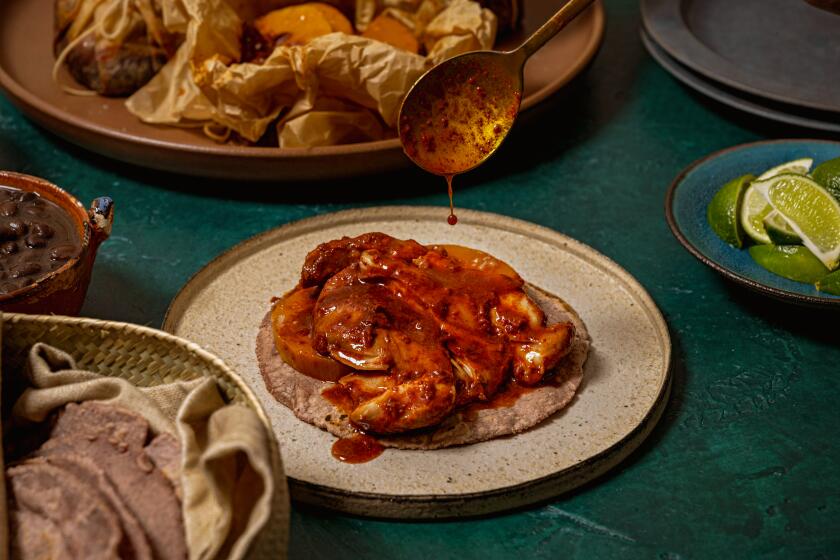Andouille-turkey salad with spiced pumpkin seeds
- Share via
RIGHT now, you can’t blink without seeing pumpkins in the supermarket, at the farmers market, even in restaurants, where they are treated more as eye candy than food. They’re the little round reproach from the vegetable world, a truly seasonal food that any serious cook should feel compelled to take home immediately and turn into dinner.
But even if the spirit is willing, the pumpkin’s flesh is weak. The average squash is mostly watery pulp, which works well enough in a pie or a soup but is not worth wrestling with more than once a year. I prefer the pumpkin’s hidden assets, the ones you don’t need a cleaver and an afternoon to tap into. With a bag of pumpkin seeds and a bottle of pumpkin seed oil, you can put the essence of autumn into everything from salad to dessert.
The seeds, often sold by the more seductive Mexican name pepitas, are the poor man’s pignoli. They are almost as meaty and rich as pine nuts, but they sell for a fraction of the price ($3 to $5 a pound compared with $10 to $15). You can exploit them much the same way, ground in pesto or toasted as a garnish in salads, and you can take them much further in salsas and sauces.
The oil, which has only recently started turning up in markets, is an amazing product, as far from Wesson as Scharffen Berger chocolate is from Nestle’s. It’s dark and thick with a haunting flavor that justifies the price (about $14 for a 250-milliliter bottle of Styrian oil from Austria, for instance). You can use it like regular old extra-virgin olive oil, in vinaigrettes, but it’s more like walnut or hazelnut oil. A little goes a long way. When you lightly glaze a winter squash with it before roasting, the taste is pumpkin squared.
I’ve been hooked on the seeds and the oil for a couple of years now, but I only realized how versatile they are when I started cooking for a big party a couple of weeks ago. There was no theme to the menu beyond fall, and somehow the two ingredients worked their way into almost every course. I toasted the seeds with a heavy coating of cayenne, sugar and salt with the idea of setting them out as snack with drinks, then realized they would be and they were the hot and crunchy accent the rice salad with andouille and turkey needed. A little pumpkin seed oil in the vinaigrette with orange and thyme brought the flavors together even more.
Another warm salad, with white beans, pancetta, rosemary and red onion, also needed a little lift, so I used the oil on cubes of butternut squash dusted with a little Aleppo chile powder, then folded those in. And the last of the seeds went onto the chocolate-cinnamon brittle for a cookie plate. Like pumpkin itself, the seeds can go sweet and savory.
You could extract the seeds from your own pumpkin and hull them, but the best seeds are store-bought. You save hours, and you get bigger kernels.
Raw, the seeds taste like a good-for-you indulgence, but roasting or toasting the seeds brings out a nuttier, warmer, richer flavor. Most recipes advise toasting them in a dry saute pan over medium heat, tossing them until they pop and brown, but I’ve found roasting produces a more even crunch. About 10 minutes on a rimmed baking sheet in a 375-degree oven is all it takes. Shake the pan often so they don’t burn.
To flavor the seeds, you can just drizzle them with tamari before you roast them. If you want a jazzier taste, coat them with a little egg white to make salt and cayenne or curry powder adhere to each seed. If you don’t immediately eat every warm seed, you can save them for a garnish, particularly for squash or pumpkin soup, or for the crunch factor in a grated carrot salad (with a pumpkin oil vinaigrette, of course).
Unlike oily nuts, pumpkin seeds can be stored at room temperature about as long as sugar. The oil, though, should be kept in the refrigerator to keep it from turning rancid.
If the seeds and oil lack anything, it’s the glamour quotient of the whole pumpkin. But this is one case where it’s what’s inside that counts.
Place the orange juice in a small heavy saucepan over medium heat and simmer until reduced to about 2 tablespoons, about 20 minutes.
While the juice reduces, brown the sausages in a nonstick skillet over medium heat, 3 to 5 minutes. Drain and combine in a very large bowl with the rice, turkey, celery, green onions and peppers. Toss until well mixed.
Whisk together the reduced juice, vinegar, orange zest, garlic and thyme in a small bowl. Whisk in the pumpkin seed and peanut oils until the dressing is emulsified. Season with salt and pepper to taste. Pour the dressing over the rice mixture and toss until coated. Just before serving, add the pumpkin seeds and toss again until well mixed. Taste and adjust the seasoning, then serve. (This is best at room temperature.)
Get our Cooking newsletter
Get a taste of Los Angeles — and the world — with recipes and kitchen tricks from the L.A. Times’ Cooking newsletter.
You may occasionally receive promotional content from the Los Angeles Times.














